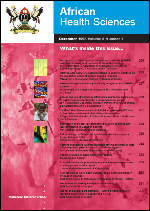
|
African Health Sciences
Makerere University Medical School
ISSN: 1680-6905
EISSN: 1680-6905
Vol. 21, No. 1, 2021, pp. 29-38
|
 Bioline Code: hs21012
Bioline Code: hs21012
Full paper language: English
Document type: Research Article
Document available free of charge
|
|
|
African Health Sciences, Vol. 21, No. 1, 2021, pp. 29-38
| en |
Predictors of antiretroviral therapy interruptions and factors influencing return to care at the Nkolndongo Health District, Cameroon
Nsoh, Marius; Tshimwanga, Katayi E; Ngum, Busi A; Mgasa, Avelina; Otieno, Moses O; Moali, Bokwena; Sirili, Nathanael; Atanga, Ndeso S & Halle-Ekane, Gregory E
Abstract
Background: Antiretroviral therapy is a lifelong commitment that requires consistent intake of tablets to optimize health
outcomes, attain and maintain viral suppression.
Objective: We aimed to elicit predictors of treatment interruption amongst PLHIV and identify motivating factors influencing
return to care.
Method: We conducted a cross-sectional study using a mixed-method approach in four hospitals in Yaoundé. Sociodemographic
and clinical data were collected from ART registers. Using purposeful sampling, thirteen participants were enrolled
for interviews. Quantitative data were analyzed using Epi-Info and Atlas-TI for qualitative analysis. Ethical clearance approved
by CBCHS-IRB.
Results: A total of 271 participants records were assessed. The mean age was 33 years (SD±11years). Private facilities CASS
and CMNB registered respectively 53 (19.6%) and 14 (5.2%) participants while CMA Nkomo and IPC had 114 (42.1%) and
90 (33.2%) participants. Most participants (75.3%) were females [OR 1.14; CI 0.78-1.66] compare with males. 78% had no
viral load test results. Transport cost and stigmatization constituted the most prominent predictors of treatment interruption
(47.5%) and (10.5%) respectively. Belief in the discovery of an eminent HIV cure and the desire to raise offspring motivated
30% and 61%, respectively to resume treatment.
Conclusion: Structural barriers like exposed health facility, and dispensing ARVs in open spaces stigmatizes clients and
increases odds of attrition. Attrition of patients on ART will be minimized through implementation of client centered approaches
like multiplying proxy ART pick points, devolving stable clients to community ARV model.
Keywords
ART interruption; attrition; return to care; predictors; motivating factors; Cameroon.
|
| |
© Copyright 2021 - Nsoh M et al.
|
|
